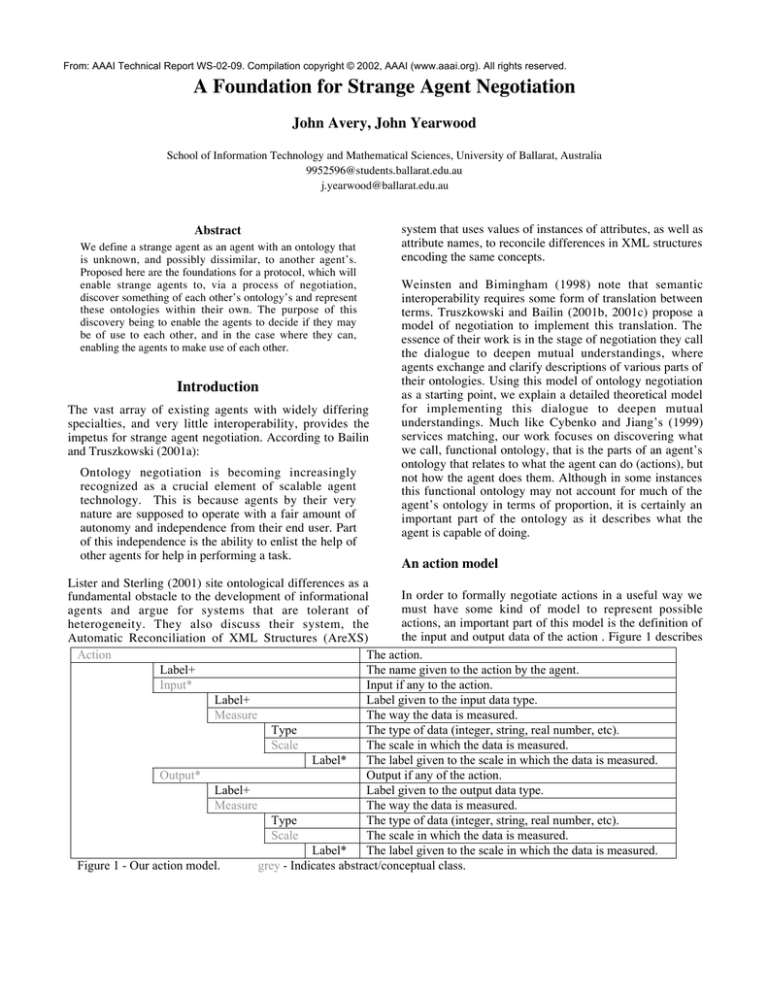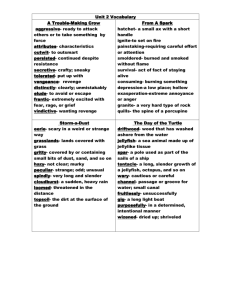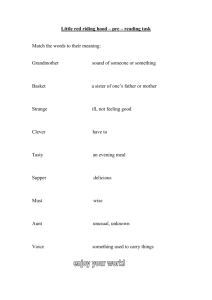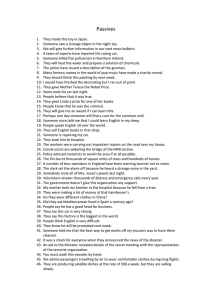
From: AAAI Technical Report WS-02-09. Compilation copyright © 2002, AAAI (www.aaai.org). All rights reserved.
A Foundation for Strange Agent Negotiation
John Avery, John Yearwood
School of Information Technology and Mathematical Sciences, University of Ballarat, Australia
9952596@students.ballarat.edu.au
j.yearwood@ballarat.edu.au
Abstract
We define a strange agent as an agent with an ontology that
is unknown, and possibly dissimilar, to another agent’s.
Proposed here are the foundations for a protocol, which will
enable strange agents to, via a process of negotiation,
discover something of each other’s ontology’s and represent
these ontologies within their own. The purpose of this
discovery being to enable the agents to decide if they may
be of use to each other, and in the case where they can,
enabling the agents to make use of each other.
Introduction
The vast array of existing agents with widely differing
specialties, and very little interoperability, provides the
impetus for strange agent negotiation. According to Bailin
and Truszkowski (2001a):
Ontology negotiation is becoming increasingly
recognized as a crucial element of scalable agent
technology. This is because agents by their very
nature are supposed to operate with a fair amount of
autonomy and independence from their end user. Part
of this independence is the ability to enlist the help of
other agents for help in performing a task.
system that uses values of instances of attributes, as well as
attribute names, to reconcile differences in XML structures
encoding the same concepts.
Weinsten and Bimingham (1998) note that semantic
interoperability requires some form of translation between
terms. Truszkowski and Bailin (2001b, 2001c) propose a
model of negotiation to implement this translation. The
essence of their work is in the stage of negotiation they call
the dialogue to deepen mutual understandings, where
agents exchange and clarify descriptions of various parts of
their ontologies. Using this model of ontology negotiation
as a starting point, we explain a detailed theoretical model
for implementing this dialogue to deepen mutual
understandings. Much like Cybenko and Jiang’s (1999)
services matching, our work focuses on discovering what
we call, functional ontology, that is the parts of an agent’s
ontology that relates to what the agent can do (actions), but
not how the agent does them. Although in some instances
this functional ontology may not account for much of the
agent’s ontology in terms of proportion, it is certainly an
important part of the ontology as it describes what the
agent is capable of doing.
An action model
Lister and Sterling (2001) site ontological differences as a
In order to formally negotiate actions in a useful way we
fundamental obstacle to the development of informational
must have some kind of model to represent possible
agents and argue for systems that are tolerant of
actions, an important part of this model is the definition of
heterogeneity. They also discuss their system, the
the input and output data of the action . Figure 1 describes
Automatic Reconciliation of XML Structures (AreXS)
Action
The action.
Label+
The name given to the action by the agent.
Input*
Input if any to the action.
Label+
Label given to the input data type.
Measure
The way the data is measured.
Type
The type of data (integer, string, real number, etc).
Scale
The scale in which the data is measured.
Label*
The label given to the scale in which the data is measured.
Output*
Output if any of the action.
Label+
Label given to the output data type.
Measure
The way the data is measured.
Type
The type of data (integer, string, real number, etc).
Scale
The scale in which the data is measured.
Label*
The label given to the scale in which the data is measured.
Figure 1 - Our action model.
grey - Indicates abstract/conceptual class.
our action model. Note that our action model is an abstract
representation of actions and the concepts of the model
may be represented in many ways in an actual agent’s
ontology.
Within the context of our action model, the functional
ontology negotiation process is a process of negotiation in
which strange agents discover each other’s possible actions
by discovering mutually understood parts of an action and
by reconciling differences in parts of the action which are
not mutually understood.
Reconciliation
For mutual understanding to be reached understanding
must be shared at each level of the action tree hierarchy.
Although the reconciliation of data and actions cannot be
completely delineated, as understanding the data may
facilitate understanding the action and vice-versa, we have
found the distinction between actions and their data a
useful subdivision to make when discussing the various
means of reconciling them.
For agents to attempt to understand each other’s ontology,
there must be some common conceptual ground to work
from, it is from this springboard that our ontology
negotiation begins. Our negotiation process begins after the
stage that Truszkowski and Bailin [4] name guess, confirm
and clarify, in which the agent has determined the strange
agents basic job description via a simple dialogue and now
desires to learn more about it. Figure 2 shows a simple
guess, confirm, and clarify dialogue.
Agent
StrangeAgent
What do you do?
I am the University of Ballarat credit
transfer agent.
Agent
OK… So you can tell me if I am
eligible for credit in computing units
offered by the University of Ballarat.
StrangeAgent
Yes… I can find correlations between
units at the Univeristy of Ballarat, and
other universities.
Agent
OK
Figure 2 – A simple guess, confirm, and clarify example.
The next step is for Agent to ask for a description of the
action that they are interested in. This corresponds to a
request for the labels of the action and it’s data (i.e. it’s
input and output). On receiving the labels of the action
from StrangeAgent, Agent attempts to represent this action
in it’s own ontology and responds to StrangeAgent with a
reformulation of the labels of this action. StrangeAgent,
who generally should have a greater understanding of this
action than Agent, then either confirms or clarify’s Agents
description of this action. Clarification of the action label
takes the form of a new description of the action,
clarification of data labels is discussed in the next section.
This process of continuous reformulations continues until
the action is understood, one or both of the agents decide
that the action can never be understood by Agent, or Agent
determines that the action will not be useful to it. Once the
action’s label, and the data types have been understood by
Agent, Agent can represent the action within it’s own
ontology. If Agent wishes to know other actions a new
action negotiation can begin.
When attempting to come to mutual understanding about
data types, the first step is the reformulation process similar
to that used in action label reconciliation. When the agents
believe a mutual understanding of the data label has been
reached StrangeAgent can communicate the data type to
Agent. Agent can then test it’s understanding of the data
label. The method of testing depends on the data type.
String data can be tested by an exchange of possible
instances. For example two agents hoping to exchange
information about universities might have the dialogue
shown in Figure 2.
StrangeAgent
The input data is labeled course and
contains strings.
Agent
OK… So course contains information
such as “Bachelor of Computer
Science” and “Bachelor of Information
Technology”?
StrangeAgent
No… Course contains such information
as “Introduction to Operating Systems”
and “C Programming”.
Agent
OK… It also contains information such
as “Systems Programming” and
“Software Engineering”?
StrangeAgent
Yes.
Agent
OK.
Figure 3 – Reconciling string data types.
StrangeAgent informs Agent that the input data is labeled
“course”, Agent has it’s own data type labeled course,
therefore believing understanding to be reached Agent tests
this understanding by giving some example instances.
StrangeAgent however does not recognise these instances
as belonging to course, so provides some instances that do
belong to course. These instances cause Agent to come to a
different understanding about course (maybe Agent calls
these pieces of information units, or subjects), and attempt
to verify this new understanding. StrangeAgent then
confirms Agent’s new understanding.
If the data type is numeric (real, integer, etc) then before
testing the concept the agents first use the reformulation
process to come to a mutual understanding about the scale
of the data. If this understanding is reached Agent can test
it’s understanding by providing a standard measure, for
example an agent attempting to understand a strange agents
concept of temperature may provide the value for the
boiling point or freezing point of water. The strange agent
may then involve the agent in counter reconciliation for the
meaning of the standard; values can then be compared and
verified. Figure 3 shows a possible negotiation testing a
numerical data type hypothesis.
No.
1
State
Start
Agent
StrangeAgent
Agent
2
Reconciling
Action Label
Reconciling
Data Label
Reconciling
Data Scale
Label
Testing Data
Reconciliatio
n
Reconciling
Data Scale
What is the data scale?
The data scale is degrees celsius.
OK… So the boiling point of water is
100?
StrangeAgent
By boiling point of water do you mean
the temperature at which water turns
from liquid to gas.
Agent
Yes.
StrangeAgent
Then yes, in this scale the
boiling point of water is 100.
Agent
OK.
Figure 4 – Testing a numerical hypothesis.
If no understanding about the scale can be reached, the
agents can attempt to come to a mutual understanding of
the scale by comparing standards or other mutually
understood concepts and searching for relations between
the known scales of the data label (which has already been
reconciled) and the unknown scale. For example agents
could reconcile the notions of degrees Celsius and degrees
Fahrenheit by comparing two standards (boiling and
freezing points of water for example) and making the
assumption that the relation was linear. This hypothesis
could be tested by the comparison of other standards (such
as standard lab conditions or the current temperature).
Negotiation Protocol
A negotiation protocol is a set of rules that govern a
negotiation. The negotiation protocol consists of the
permissible players, the possible states of the negotiation,
and the valid acts of players in particular states. The
permissible players in our negotiation are any two agents
implementing the protocol. The negotiation consists of
eight possible negotiation states whose purpose and
relationships are shown in Figure 5 and 6.
1
2
3
4
5
6
7
Description
The Guess, Confirm and Clarify
stage has been completed and
the agents are ready to begin an
action negotiation.
The agents begin negotiating
about a specific action.
The agents attempt to reconcile
the data types of the action
The agents attempt to reconcile
the scale of the data.
The agents believe data has
been reconciled and test this
understanding.
The data scale is unknown to
agent so an attempt to
determine the scale is made.
At least one part of the action
could not be reconciled.
Action could
not be
Reconciled
8
Action and The action and its data has been
Data Labels reconciled.
Reconciled.
Figure 6 – The negotiation states.
Within each of these states there are valid actions, Figures
8-14 list and describe the various negotiation acts possible
from each state of the negotiation. To demonstrate the
protocol the example from figure 3 is presented and
formatted according to the negotiation acts in figure 7.
Strange Agent-InformDataLabel(“course”)
InformDataType(“string”)
Agent IndicateUnderstandingOfDataLabel(“course”)
ProvideExampleOfData(“Bachelor of Computer
Science”, “Bachelor of Information Technology”)
Strange Agent-ProvideAlternativeExamplesOfData(“Introduction to
Operating System”,“C Programming”)
Agent IndicateUnderstandingOfDataLabel(“course”)
ProvideExampleOfData(“Systems Programming”,
“Software Engineering”)
Strange Agent- AffirmExamplesOfData()
Figure 7 – Negotiation from figure 3 presented in
negotiation acts.
3
7
4
5
6
8.
Figure 5 – Relationships between negotiation states.
Action
Initiated
by
Agent
Description
Negotiate
Agent wishes to begin
Action(action)
reconciliation of action.
InformAction
Strange
Strange agent informs
Label(label)
Agent
agent of action label.
InformData
Strange
Strange agent informs
Label(lLabel)
Agent
agent of data label.
Figure 8 – Valid actions possible from the Start state.
Action
Action
Indicate
Understanding
OfActionLabel
(label)
Reformulate
ActionLabel(r
e-formulation)
Affirm
Reformulation
OfActionLabel
()
Correct
Reformulation
OfActionLabel
(correction)
Initiated
by
Agent
Description
Agent believes they
understand action label.
Agent reformulates
action label and informs
strange agent.
Strange
Strange agent affirms
Agent
that agent’s
reformulation was
accurate.
Strange
Strange agent provides
Agent
an alternate label for the
action as agent’s
reformulation was
inaccurate.
SuspendActio
Agent or Agent or strange agent
nLabel
Strange
suspends the action
Reconciliation Agent
negotiation so that a data
(data label)
label can be reconciled
before proceeding.
QuitAction
Agent or Agent or strange agent
LabelReconcil Strange
decides that action
iation(label)
Agent
cannot be reconciled.
Figure 9 - Valid actions possible from the Reconciling
Action Label state.
Action
AssertStandar
d(standard)
Reformulate
Standard (reformulation)
Affirm
Reformulation
OfStandard()
Correct
Reformulation
OfStandard
(correction)
ProvideValue
ForStandard
(value)
QuitDataScale
Reconciliation
(label)
Agent
Initiated
by
Agent or
Strange
Agent
Agent or
Strange
Agent
Agent or
Strange
Agent
Agent or
Strange
Agent
Agent or
Strange
Agent
Agent
StrangeA
gent
Description
Either agent asserts a
standard to be used for
reconciling data scale.
Receiving agent
reformulates standard.
Reformulation is
affirmed.
Reformulation was
inaccurate and a
corrected reformulation
is provided.
A value is provided for
an agreed upon standard.
Agent or strange agent
decides that data scale
label cannot be
reconciled.
Figure 10 - Valid actions possible from Reconciling
Data Scale state.
InformData
Type(type)
Indicate
Understanding
OfDataLabel
(label)
Reformulate
DataLabel(reformulation)
AffirmReform
ulationOfData
Label()
Correct
Reformulation
OfDataLabel
(correction)
Initiated
by
Strange
Agent
Agent
Description
Agent
Agent reformulates data
label and informs strange
agent.
Strange agent affirms
that agent’s
reformulation was
accurate.
Strange agent provides
an alternate label for the
data as agent’s
reformulation was
incorrect.
Agent believes they
understand data label and
presents some example
data.
Strange agent affirms
that agents examples of
data were appropriate.
Strange agent provides
alternative examples to
those provided by agent.
Strange
Agent
Strange
Agent
Strange agent informs
agent of the data’s type.
Agent believes they
understand data label.
Provide
Agent
ExamplesOf
Data
(examples)
Affirm
Strange
ExamplesOf
Agent
Data()
Provide
Strange
Alternative
Agent
ExamplesOf
Data
(examples)
QuitDataLabel Agent or Agent or strange agent
Reconciliation Strange
decides that data label
(label)
Agent
cannot be reconciled.
Figure 11 - Valid actions possible from the Reconciling
Data Label state.
Action
Finish
Negotiation()
Initiated
by
Agent
Description
Agent has finished
negotiating with strange
agent.
Negotiate
Agent
Agent wishes to begin
Action(action)
reconciliation of another
action.
Figure 12 – Valid actions possible from the Action and
Data Labels Reconciled, and the Action Could Not Be
Reconciled states.
Action
RequestValue
ForStandard
(standard)
Reformulate
Standard(re fomulation)
Affirm
Reformulation
OfStandard()
Initiated
by
Agent
Description
Agent asks strange agent
to provide value for the
given standard.
Strange
Strange agent
Agent
reformulates the standard
and informs agent.
Agent
Agent affirms that
strange agent’s
reformulation was
accurate.
Correct
Agent
Agent provides an
Reformulation
alternate (correct)
OfStandard
description for the
(correction)
standard.
ProvideValue
Strange
Strange agent provides a
ForStandard
Agent
value for the mutually
(value)
understood standard.
AffirmValue
Agent
Agent agrees with
ForStandard()
strange agents value for
standard.
RefuteValue
Agent
Agent disagrees with
ForStandard()
strange agents value for
standard.
QuitTesting
Agent or Agent or strange agent
DataReconcili Strange
decides that data cannot
ation(label)
Agent
be reconciled.
Figure 13 - Valid actions possible from Testing Data
Reconciliation state.
Action
Initiated
by
Agent
Description
Indicate
Agent believes they
Understanding
understand data scale
OfDataScale
label.
Label(label)
Reformulate
Agent
Agent reformulates data
DataScale
scale label and informs
Label(restrange agent.
formulation)
Affirm
Strange
Strange agent affirms
Reformulation Agent
that agent’s
OfDataScale
reformulation was
Label()
accurate.
Correct
Strange
Strange agent provides
Reformulation Agent
an alternate label for the
OfDataScale
data scale as agent’s
Label
reformulation was
(correction)
incorrect.
QuitDataScale Agent or Agent or strange agent
Label
Strange
decides that data scale
Reconciliation Agent
label cannot be
(label)
reconciled.
Figure 14 - Valid actions possible from the Reconciling
Data Scale Label state.
Implementation and Facilitation
This protocol relies heavily on the ability of the
implementing agents to be able to reformulate the concepts
represented within their ontology into a new description of
that concept. This reformulation requires agents to have a
rich knowledge of their domain and the domain’s language.
There will also need to be some base concepts that are
mutually understood from which other concepts can be
derived. We contend that this is not a limitation of the
protocol but a limitation inherent in the process of strange
agent negotiation. Unless agents have very similar
understandings of the area of negotiation, they will require
this rich knowledge of their domain and their domains
language in order to arrive at a common understanding.
However, it is not necessary (although it may be beneficial)
that both agents have such rich knowledge. If one agent has
knowledge rich enough to understand the other agent’s
descriptions, and to reformulate their own descriptions into
the language of the simpler agent, then the more complex
agent can effectively teach the simple agent about the
domain by sharing with it its own reformulations of the
domain concepts.
Extending this idea we contend that a special class of
agents, that we call facilitating agents, could make the
process of implementing the protocol on existing agents
much simpler. This class of agent has a rich knowledge of
language and they aim to build information about a
particular domain and it’s language. They do this via
ontology negotiation with a wide range of agents within the
domain. These agents can then act as central enquiry
points, and serve as a proxy between agents whose own
negotiation capabilities are insignificant. Facilitating agents
have ramifications not only in the stage of negotiation
outlined in this paper but in earlier stages of negotiation
and in the location of appropriate agents to begin
negotiations with.
By using facilitating agents an existing agent can be
modified to implement a lightweight version of the
protocol which implements only those actions and states
(those that present data, and those that indicate
understanding or lack of understanding) that are required
when one party is unable to reformulate concepts. The
protocol can thus be added as a communication protocol
with no necessary modifications to agent reasoning (and
therefore can be easily added to agents with relatively
simple reasoning capabilities, or even reactive agents).
Obviously such a lightweight implementation sacrifices
much of the power provided by the strange agent
negotiation protocol, but it also significantly broadens the
potential scope of the protocol.
Intelligence, pages 223-228. Springer-Verlag: Heidelberg,
Germany..
Future Research
Future work will concentrate on three areas:
•
•
•
The design, justification and testing of a method
for measuring the amount of shared understanding
reached by agents in ontology negotiation.
Further implementation, refinement and testing of
agents, both normal and facilitating, that
implement this protocol.
The design, justification and testing of standard
frameworks for the addition of this protocol to an
existing agent, and for the creation of an agent
implementing this protocol.
Conclusion
The foundation we present will enable strange agents
implementing our protocol to engage in functional
ontology negotiation, and through this negotiation discover
the ontology of each other’s actions, enabling them to
make use of these actions. Imperative to this process is the
abstraction provided by our action model and the aspects of
the protocol that use this model to facilitate the
reconciliation of concepts at least partially understood by
both agents, but internally represented in different ways.
References
Bailin, Sidney C., and Truszkowski, Walt,. 2001a,
Ontology Negotiation Between Scientific Archives, in
Proceedings of the 13th International Conference on
Scientific and Statistical Database Management, pages
245-250, IEEE Computer Society Fairfax, Virginia, USA.
Cybekno, G. and Jiang, G, 1999, Matching Conflicts:
Functional Validation of Agents, Agent conflicts: Papers
from the AAAI Workshop. Technical Report WS-99-08,
AAAI Press, Menlo Park, CA.
Lister, K, and Sterling, L, 2001, Agents in a Multi-cultural
World: Towards Ontological Reconciliation, In Stumptner,
M, Corbett, D, Borrks, M (Eds), Advances in Artificial
Intelligence, Proceedings of the 14th Joint Conference
AI2001,number 2256 in Lecture Notes in Artificial
Intelligence, pages 321-332 Springer-Verlag: Berlin,
Heidleberg, New-York.
Sidney C. Bailin and Walt Truszkowski. 2001b Ontology
negotiation as a basis for opportunistic cooperation
between intelligent information agents. In Matthias Klush
and Franco Zambonelli, (Eds), Cooperative Information
Agents V, Proceedings of the 5th International Workshop
CIA 2001, number 2182 in Lecture Notes in Artificial
Truszkowski, Walt, and Bailin, Sidney C., 2001c, Ontology
Negotiation Between Strange Agents, In International
Conference on Advances in Infrastructure for Electronic
Business, Science and Education on the Internet,
SSGRR’2001.
Weinstein, Peter C., and Birmingham William P., 1998
Agent communication with Differentiated Ontologies,
submitted for journal review December 1998, available
from
http://citeseer.nj.nec.com/
cache/papers/cs/5550/http:zSzzSzwwwpersonal.engin.umich.eduzSz~peterwzSzFaculty.appzSzjai
r 121098.pdf/weinstein98agent.pdf








